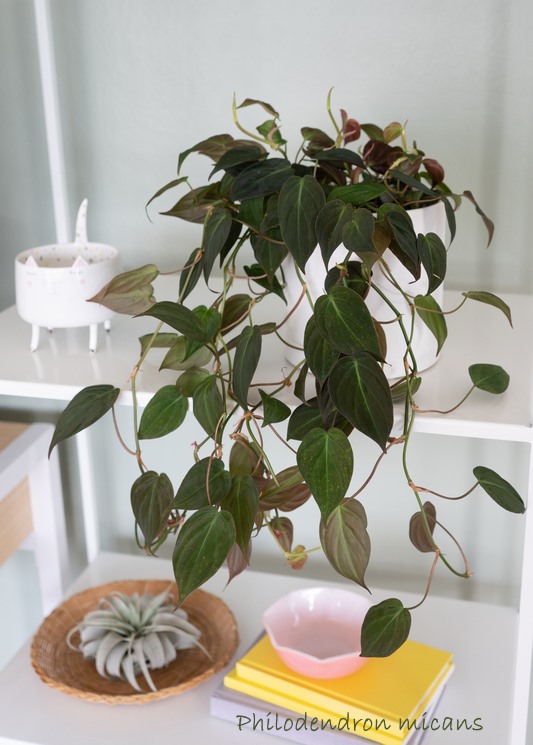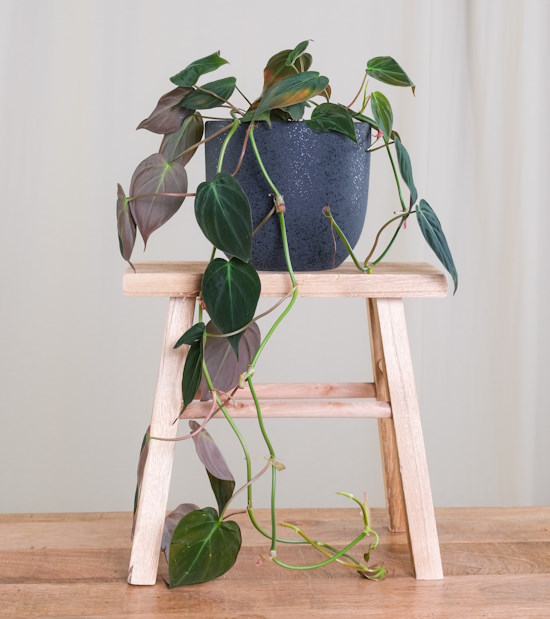Philodendron Micans Care
Philodendron micans sport velvety leaves along trailing vines, lending an elegant appeal you'd expect from a demanding houseplant. Fortunately for us, this variety also happens to be easy to grow.
Get to know P. micans and discover how to grow it as a houseplant. Here you'll discover how much water it wants year-round, why you may want to boost the humidity, how to pinch and prune, plus tips for heading off houseplant troubles.
 Velvet leaves make P. micans a stunning houseplant. Photo ©Ida Taing
Velvet leaves make P. micans a stunning houseplant. Photo ©Ida TaingGet to Know Philodendron Micans
Natives of the tropical Central and South American jungles, Philodendrons provide an ever-growing assortment of dazzling and dependable foliage houseplants. And this velvety-leafed vine is one you'll want to add to your collection.
Soft, new leaves emerge green with a bronze tinge, and are purple-red underneath. As they grow, the leaves turn darker green. Those heart-shaped leaves grow alternately on slender stems, which will eventually trail -- or readily climb, if given support.
How big does Philodendron micans get? You can expect this tropical houseplant to climb or trail to 4 ft (1.2 m) or more. Of course, you can cut the stems back to any length to suit you.
Display Tip
Allow P. micans slender stems to trail or give it something to climb...it's up to you.
Show this beautiful tropical houseplant to its best advantage by displaying it with a plain background.
Known botanically as Philodendron hederaceum micans, this evergreen tropical is surprisingly adaptable to living indoors, tolerating average room conditions.
Pinch your plant. You'll get a fuller, bushier houseplant by pinching off the growing tips. Stems will branch out if pinched off after a leaf node (the place where the leaf is attached to a stem).
Yellow leaves are a symptom of cold temperatures or too much sunlight. If your houseplant is otherwise healthy, it may be lacking sufficient micronutrients, such as magnesium and calcium. Don't forget to fertilize your plant.
Brown leaf tips are caused by dry air. Boosting the humidity around your tropical houseplant is easier than you may think. (See "Humidity" tips below.)
Wondering when to repot? Probably every couple years, or when it outgrows its container. Slip a young Philodendron micans out of its pot and take a peek at its roots. Are they packed and coiled at the bottom of the pot? If so, it's definitely time to repot. Move the plant to a container 1- to 2-inches (2.5-5 cm) larger. Don't over-pot because a large container will hold too much water, which may lead to root rot.
Something bugging your plant? Watch for aphids that attracted to new growth. They feed on plants by sucking sap, then excreting honeydew -- a sticky substance that may drip on the table or floor and attract ants. Caught early, they can be washed off the plant with room-temperature water. Otherwise, treat it with insecticidal soap.
 Velvety leaves add instant style to any room. Image credit Feey
Velvety leaves add instant style to any room. Image credit FeeyPhilodendron Micans Care
Light: Bright, indirect light. Small leaves or long spaces between leaves show that the plant is not getting enough light. Move your philodendron plant to a brighter location, but not into hot, direct sun which can burn its leaves, causing brown scorch marks. Don't have a sunny spot? Micans thrives under grow lights, making it an ideal office plant.
Water: Water Philodendron Micans thoroughly, then allow the top 1-inch (2.5 cm) of soil to dry out before watering again. Always use tepid water for your houseplants because cold water is a shock to these tropical natives. Yellow leaves are caused by over-watering.
Humidity: Maintain at least 45% relative humidity. Indoor humidity can drop drastically in winter without our noticing it. It's a good idea to use a humidity gauge near your tropical houseplants, rather than guess. For best results, use a cool-mist room humidifier. Brown leaf tips are a symptom of dry air.
Temperature: Average room (65-80°F/18-27°C). Keep this tropical native warm year-round. Don't expose your houseplants to cold blasts from an entryway or set them near a heat/AC vent.
Soil: Slightly acidic. Peat moss-based mix with added perlite will help drainage. African violet potting mix is ideal.
Fertilizer: Feed once a month spring through fall with a balanced water-soluble fertilizer, diluted to half-strength. Stop fertilizing in winter, when growth is slow.
Propagation: Take 3-4 in/7-10 cm-long stem tip cuttings (each with at least 3 leaves attached) in spring or early summer. Cut just below a leaf node (the place where the leaf is attached to the stem). Nodes contain cells that will develop new roots. Philodendron Micans roots easily in water or lightly moist soil, within a few weeks.


